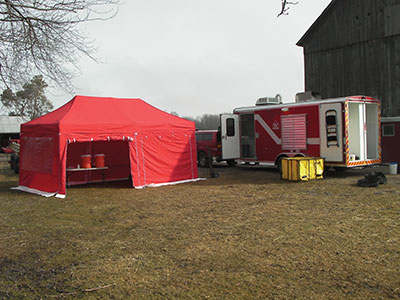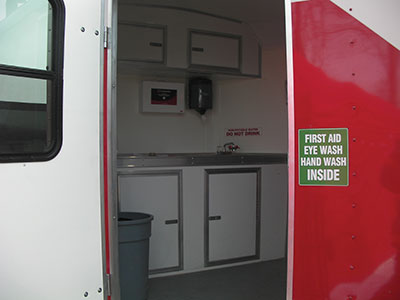
Features
Hot topics
Incident reports
Lessons learned
It isn’t often enough that good things come out of a bad event, but over the last 15 months, that is exactly what has happened in the Township of St. Clair in Ontario.
September 9, 2013
By Steve Bicum
It isn’t often enough that good things come out of a bad event, but over the last 15 months, that is exactly what has happened in the Township of St. Clair in Ontario.
 |
|
| After a major fire in 2011, the St. Clair Township Fire Department recognized the need for better rehabilitation, hygiene and breathing air facilities. With $100,000 from council, the department bought a mobile air filling station and a tandem-axel, six-metre enclosed, insulated trailer, which was customized by volunteers into three compartments. Photos by St. Clair township fire department |
The background
The Township of St. Clair is a diverse community located about one hour west of London and more than an hour north of Windsor. The 15,000 residents live in small urban centres and small family farms dot the township. The St. Clair Township Fire Department is composed of 180 volunteer firefighters deployed in six fire stations with a full-time chief and deputy chief.
On Dec. 20, 2011, a 2,800-square-metre (30,000-square-foot) boat storage facility caught fire and burned to the ground. The building and contents were valued at $50 million. A second building, located four metres (14 feet) away, valued at an additional $50 million, was saved. (For a more detailed account, see the September 2012 issue of Fire Fighting in Canada). In that article, several issues were identified, such as building access, firefighter rehabilitation and hygiene, and breathing-air supply. The fire department has spent the last 15 months working to resolve these issues.
The resolution
A concerted effort by a number of people was made to work out solutions and to implement them.
 |
|
| The new trailer was completed in January and was used during a structure fire on the coldest night of the year; more than 20 SCBA cylinders were filled on site.
|
Building access for fire fighting was one of the issues identified during the post-incident analysis and review (PIAR). Along with this came the issue of pre-incident planning. The fire department has worked hard to develop and nurture a relationship with building department officials. This ensures that everyone is working toward the greater good, and that safety issues don’t become a turf war over who has jurisdiction. Now there is no hesitation for either side to pick up the phone and talk to each other about issues regarding a building or site plan. The fire department has also redoubled its efforts to ensure that fire crews get out and pre-plan these types of occupancies. After a devastating event such as this fire, fire crews could see the benefit of going out and thinking of solutions before they roll up on scene with $50 million worth of product going up in flames. These efforts to build relationships and be proactive ultimately improve safety for the public and for the firefighters.
The fire department was able to develop a solution to the remaining issues of rehabilitation, hygiene and breathing air, in one package. With the full support of the township’s council, almost $100,000 was secured to design and build a mobile air filling station that would address the concerns brought forth in the PIAR. Mayor Steve Arnold said, “It is important to us on council that we provide the best equipment we can to our volunteers. Their safety is our priority and this air trailer will help keep them safe.” Efforts to find a pre-designed, pre-packaged solution were unsuccessful. There was nothing on the market that would address all of the concerns. So, the solution was to build our own.
A tandem-axle six-metre (20-foot) enclosed, insulated trailer was custom ordered with a large vent opening on the side, walk-in doors, and air conditioning. With the help of some volunteers, the trailer was divided into three separate areas. In the front are a countertop and sink with first-aid and eye-wash facilities. A fridge full of cold water and other rehab supplies is in this air-conditioned area. Also, a Jordair bottle fill station is set up here so bottle filling can be taken care of in a controlled environment. In the next separate compartment over the axles is a Jordair 23-cubic-feet-per-minute (CFM) diesel-powered breathing air compressor, along with a 5,500-watt diesel generator and the four-bottle 6,000-pound-per-square-inch (psi) cascade system. This area has temperature-controlled louvres and soundproofing to control noise levels. The third area has two purposes. One is to store the 80-litre (21-gallon) fuel tank, which offers about eight hours of operating time. The area also stores a small water tank for non-potable water, a six-metre by three-metre tent for rehab, along with additional rehabilitation supplies. The second area houses a port-a-potty (enough said).

|
|
| A fire in December 2011 caused $50 million in damages to a boat-storage warehouse in St. Clair Township, Ont., and tested the community’s emergency planning.
|
The layout of the trailer puts only 220 kilograms (485 pounds) of weight on the tongue of the trailer with the overall weight being 2,700 kilograms (5,952 pounds). This allows the trailer to be pulled by a standard pick-up truck. The trailer is kept at one of the fire stations and responds to structure fires and any other call that the chief on call deems necessary.
Since the trailer was completed in January 2013, it has responded to a residential structure fire on the coldest night of the year – it was -16 C, plus wind chill. More than 20 SCBA cylinders were filled on site, ensuring a constant air supply, and the heated shelter of the trailer provided the firefighters with a place to thaw out. Fire Chief Roy Dewhirst pointed out, “This unit will be a real asset to the department. We can now offer a greater level of safety and care for our firefighters that we didn’t have before.”
The St. Clair Marina Boat Storage fire was a tragic and costly accident. Millions of dollars in property were lost, along with many families’ possessions. Luckily, no one was injured. Too often, it takes a large-scale incident like this to highlight issues. However, this gave the St. Clair Township Fire Department the opportunity to assess its capabilities and develop a response to the issues that will make it stronger, more efficient and safer for the future.
Steven Bicum is the deputy fire chief (co-ordinator of training and safety) with the St. Clair Township Fire Department. He began his career as a volunteer with the Wilkesport Station, where he was training officer, captain and fire prevention officer. He has been chair of Lambton County Fire Prevention Association, vice-president of the Lambton-Kent Firefighter Association, and an adjunct faculty member at the Lambton College Fire Emergency Response Training Centre. He is an associate instructor for the Ontario Fire College. Bicum has deep roots in St. Clair Township: his children are the fifth generation to live on their family farm. Contact him at sbicum@twp.stclair.on.ca
Print this page